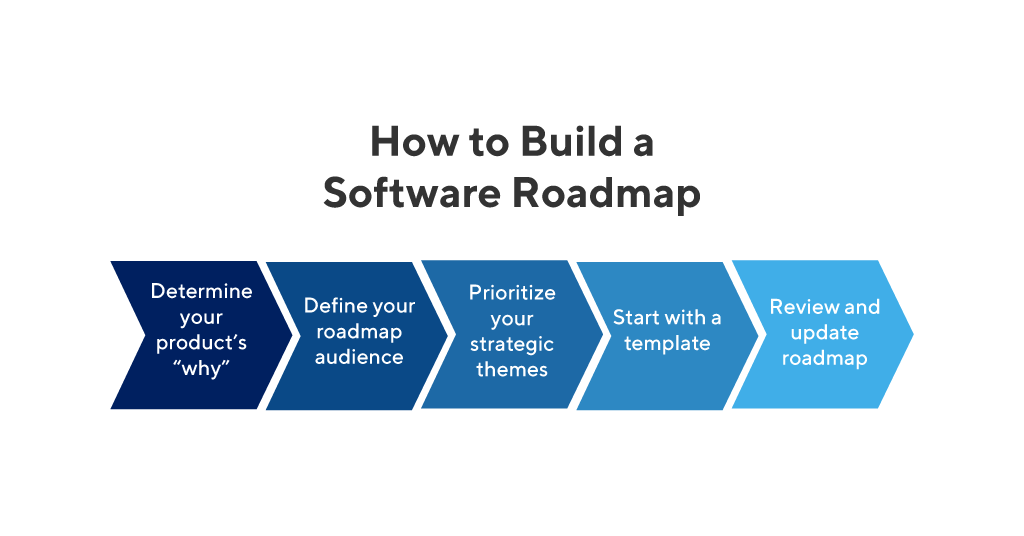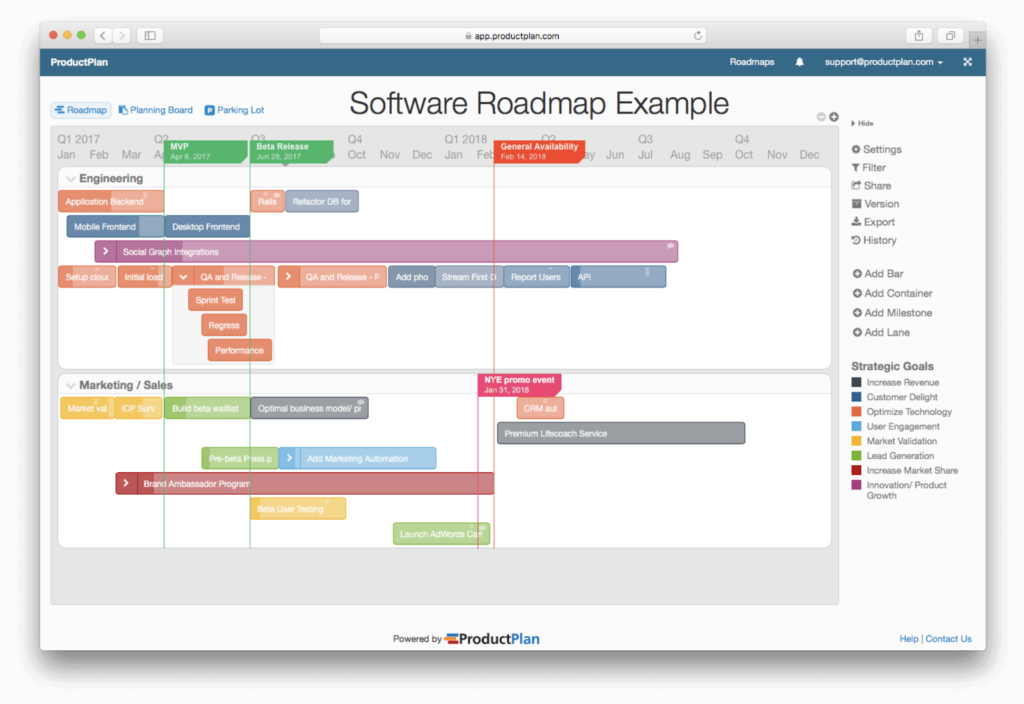What is a Software Roadmap?
A product roadmap is a high-level visual summary of a company’s vision and strategic objectives for its product. A software roadmap is a roadmap specifically for a software product.
When and Why do You Need a Software Roadmap?
Developing a software product, like any other type of product, follows a logical sequence of stages.
An organization first determines its vision for the product. The product team translates this vision into a blueprint that includes a long-term view of the product’s strategic goals and themes. This is the product roadmap stage. Finally, a cross-functional team of project managers, developers, and other groups will convert the roadmap’s high-level plan into actionable tasks.
As you can see, a useful software product manager needs a roadmap to serve as a bridge connecting the company’s product vision to the tasks required to bring that product to market.
What are the Benefits of a Software Roadmap?
1. It helps your developers understand how their work contributes to the bigger picture.
When you give your development team access to your roadmap, they gain a sense of how daily work contributes to the product as a whole.
Access to your roadmap can help motivate your development team. When your dev team sees how their coding tasks help shape the product—and ultimately improve the lives of the product’s users—your developers will feel a greater sense of contribution and purpose.
2. It helps the team make more intelligent prioritization decisions.
No matter how well-planned, product development rarely follows a predictable, linear path from project kickoff through market launch. The team’s resource levels can change at any time. Senior management can freeze budgets with little or no notice. Different needs from elsewhere in the organization can suddenly take precedence over the product’s development.
When a product team faces these unexpected changes in its plan, having a well-thought-out product roadmap can help. The roadmap allows the team to step back, review its high-level goals, and make the right decisions about where to reprioritize resources when necessary.
3. It can help persuade your stakeholders.
Showing your executive staff only a list of planned features, with no strategic explanation about why you are choosing to build your product in that specific way, might not inspire those execs to green-light your plan. Most product teams need that executive to green-light to move forward.
With that in mind, a well-crafted product roadmap also serves as a valuable tool for communication and persuasion. It can help a product team present a compelling strategic plan to the company’s executives, which can earn the team the approval it needs to begin developing its product.
Tips for Creating a Software Roadmap
Developing a roadmap should follow a sequence of strategic steps. Here is a high-level checklist for building your first roadmap from scratch:
Step 1: Determine your product’s “Why.”
Before you can decide on how to prioritize your product’s features or any other details, you first need to determine the product’s strategic reason for being. You need to know why you are planning to develop the product, what you expect it to accomplish, and for whom.
All of your other strategic decisions about building the product will flow from your answers to these initial questions.
Step 2: Determine your roadmap’s intended audiences.
You cannot develop a software product roadmap in a vacuum, or create a single version of your roadmap to share with all audiences.
Your roadmap presentation to the executive staff will need to focus on high-level strategic objectives. Your executives will be interested in how building a piece of functionality will lead to broad business goals, such as increasing revenue or raising your company’s reputation.
When you review the roadmap with your developers, by contrast, you will focus more on how your plans are going to affect the development team’s resources and workloads.
Figure out which audiences will view your software roadmap. This will help you tailor both the roadmap itself and your presentation to those various groups.
Note: You will want to create just one version of your product roadmap and switch easily between views or levels of detail. You won’t want to have to create a different draft of your roadmap for every planned audience. The easiest way to do this is by using roadmap software.

Step 3: Prioritize your product’s strategic themes.
Now it’s time to begin developing the content of your roadmap. The best practice for developing a roadmap is to start with the highest, most strategic level. Then you can add more specific details.
Here, you will start by creating categories of your product’s major planned themes. Then, you can add several epics under each theme. If you have even more detailed plans in mind, such as specific features for an epic, you can add those as well.
Here is a software roadmap example, developed in our roadmap software. You can use this template to begin drafting your roadmap:
Step 4: Review your roadmap regularly and be ready to update it.
Because product development often takes unexpected turns, you will want to review your software roadmap regularly to make sure your team is still on track with your strategic goals.
It’s important to stay flexible and ready to update your roadmap to reflect new realities or changing priorities.
Your software product roadmap isn’t meant to be a fixed, unchanging document. Updating a roadmap doesn’t say your team missed something, or that you’ve made a mistake. Often it’s just a necessary step on the path toward bringing a product successfully to the market.

Tips for Sharing Your Completed Software Roadmap
You’ve completed your roadmap and now need to present it to one or more audiences. What do you do next?
UserVoice.com suggests the seven-step SOAPBOX method for preparing your product roadmap presentation. (SOAPBOX is an acronym for the seven topics.)
Note: the UserVoice post addresses executive-level roadmap presentations in particular. But the advice they offer could also help a product manager presenting a roadmap to any audience. Here are their seven suggested steps to prepare your roadmap presentation:
1. Subject
What is the topic of your presentation? Will you be reviewing product strategy with a cross-functional team, asking your senior managers or investors for approval, etc.?
2. Occasion
How, when, and where will you give your presentation? Will it be a standalone product roadmap discussion or part of a more massive gathering? How might this affect how you deliver your presentation?
3. Audience
To whom will you be sharing your roadmap? How will this affect the order you present your strategy and plans? What level of detail will you want to show?
4. Purpose
What do you want to achieve with this presentation? Do you need the approval to move forward, to make sure your development team understands your goals, or to accomplish different other strategic objectives?
5. Before
What other materials or details will you want to have ready for the presentation? Will you want to gather supplemental data and evidence, for example, to support your strategic plans or revenue projections? Will you want to bring in subject-matter experts from other departments to answer questions that come up during your presentation?
6. Objection handling
What types of objections do you anticipate your audience raising during your roadmap presentation—proposed timelines, budgets, estimated ROI, etc.? How can you prepare to deal effectively with those objections? Might you want to raise them yourself, preemptively, during the presentation?
7. Execute
What other strategies and tactics can you apply to prepare the most compelling roadmap presentation?





